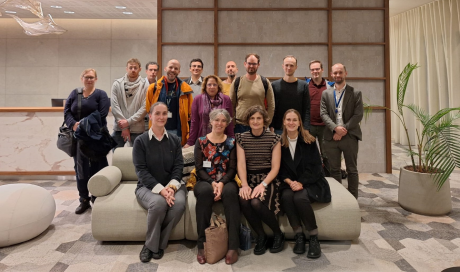SCARBOn First Formal Review
Published: December 9 / 2024
On November 7th, the SCARBOn consortium met in Brussels for its first Formal Review, hosted by the European Health and Digital Executive Agency. This review gave the SCARBOn team the opportunity to present key achievements and outline future steps to the European Commission and an external evaluator, summarizing progress made in the first 10 months of this 30-month long, EU-funded project.
SCARBOn’s mission is to design an efficient constellation of small satellites, equipped with innovative sensors: NanoCarb, a miniaturized static imaging spectrometer, and SPEXone, an aerosol sensor. This system will enable precise, reliable monitoring of CO₂ and CH₄ emissions, delivering worldwide, frequent, high-quality data to support Europe’s climate goals.
What was discussed?
The SCARBOn project team, led by Airbus Defence and Space, provided a status overview of all project Work Packages (Workplan - SCARBOn: Space Carbon Observatory next step), and discussed current developments and future directions.
As SCARBOn is a proud successor to the Horizon 2020 SCARBO project (Space Carbon Observatory | SCARBO), SCARBO’s legacy and achievements were addressed. Furthermore, SCARBOn’s technical roadmap to further advance the space-based anthropogenic greenhouse gas (GHG) monitoring solution was presented.
SCARBOn Key Up-to-Date Outcomes
In the first ten months of project implementation, the SCARBOn team made substantial progress in designing and manufacturing the NanoCarb instrument—a miniaturized static imaging spectrometer designed to detect CO₂ and CH₄ with unprecedented accuracy for such small sensors. Currently, the SCARBOn team is working on two types of the NanoCarb instrument. NanoCarb-P serves as a prototype that will later on be tested in realistic airborne conditions to monitor greenhouse gas plumes. NanoCarb-S, a space instrument, is designed for space deployment, with performance assessments tailored for satellite constellations.
NanoCarb-P Development:
- Completion of NanoCarb-P components definition, with design enhancements improving sensitivity almost two times compared to original SCARBO airborne prototype performances.
- Validation and testing of manufacturing processes for the interferometric plate according to NanoCarb-P specifications.
- NanoCarb-P optical components ready for manufacturing
NanoCarb-P Preparation for the Airborne Campaign:
- Early testing of hardware and interface components in preparation for the upcoming airborne campaign.
- Verification of the data retrieval chain using outcomes from previous NanoCarb campaigns to ensure NanoCarb’s operational reliability.
NanoCarb-S Development:
- Detailed definition of SCARBOn technical roadmap, drawing on lessons and experiences from SCARBO.
- Preliminary assessment of uncertainties in by-products measured by a hyperspectral imaging system.
- Identification of detector specifications
- Provision of thermal design analysis
Future Directions and System Optimizations
Looking ahead, SCARBOn aims to further refine its space-based GHG monitoring solution, with plans to deploy a constellation of small, cost-effective satellites (approximately 120-150 kg each) equipped for accurate monitoring with twice-daily revisit times. To reach this goal, the SCARBOn team will focus on preparing the key NanoCarb instrument and other supporting components for an airborne campaign planned for the spring of 2025. This campaign will allow for thorough instrument testing, data collection, and data processing.
With these combined efforts, SCARBOn is on its way to making a real impact on GHG monitoring, delivering a robust, scalable solution that supports Europe’s commitment to addressing climate change with accurate emissions data.
